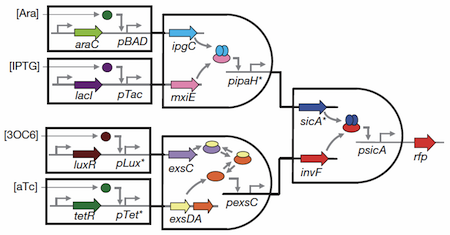Science Fiction
Dictionary
A B C D E F G H I J K L M N O P Q R S T U V W X Y Z
The Most Complex Synthetic Biology Circuit

MIT researchers have created what is being called the most complex synthetic biology circuit ever built.
Synthetic biologists design cellular circuits that can perform new functions, such as sensing environmental conditions, using genes as interchangeable parts. However, most of the circuits designed so far have been limited by the difficulty in assembling genetic components that don’t interfere with each other.

(4-input AND gate)
Unlike electronic circuits on a silicon chip, biological circuits inside a cell cannot be physically isolated from one another. “The cell is sort of a burrito. It has everything mixed together,” says Christopher Voigt, an associate professor of biological engineering at MIT.Because all the cellular machinery for reading genes and synthesizing proteins is jumbled together, researchers have to be careful that proteins that control one part of their synthetic circuit don’t hinder other parts of the circuit.
Voigt and his students have now developed circuit components that don’t interfere with one another, allowing them to produce the most complex synthetic circuit ever built. The circuit, described in the Oct. 7 issue of Nature, integrates four sensors for different molecules. Such circuits could be used in cells to precisely monitor their environments and respond appropriately.
“It’s incredibly complex, stitching together all these pieces,” says Voigt, who is co-director of the Synthetic Biology Center at MIT. Larger circuits would require computer programs that Voigt and his students are now developing, which should allow them to combine hundreds of circuits in new and useful ways.
The pathway consists of three components: an activator, a promoter and a chaperone. A promoter is a region of DNA where proteins bind to initiate transcription of a gene. An activator is one such protein. Some activators also require a chaperone protein before they can bind to DNA to initiate transcription.
Fans of science fiction writer Greg Bear recall the living "biologics" from his 1984 novel Blood Music:
Why limit oneself to silicon and protein and biochips a hundreth of a millimeter wide, when in almost every living cell there was already a functioning computer with a huge memory? A mammallian cell had a DNA complement of several million base pairs, each acting as a piece of information. What was reproduction, after all, but a compterized biological process of enormous complexity and reliability? The earliest biologic strings had been inserted into E. coli bacteria as circular plasmids...
(Read more about Greg Bear's biologics)
Via Kurzweil AI and MIT.
Scroll down for more stories in the same category. (Story submitted 10/8/2012)
Follow this kind of news @Technovelgy.| Email | RSS | Blog It | Stumble | del.icio.us | Digg | Reddit |
Would
you like to contribute a story tip?
It's easy:
Get the URL of the story, and the related sf author, and add
it here.
Comment/Join discussion ( 0 )
Related News Stories - (" Biology ")
Black Fungus Blocks Radiation
'You were surrounded by Astrophage most of the time' - Andy Weir, 2021.
Lunar Biorepository Proposed For Cryo-Preservation Of Earth Species
'...there was no one alive who had ever seen them. But they existed in the Life Bank.' - John Varley, 1977.
Let's Make Slaver Sunflowers! Engineering Plants To Reflect Light
'The mirror-blossom was a terrible weapon.' - Larry Niven, 1965.
Machete-Wielding Philodendron Isn't Going To Take It Anymore
'The tree ended its wild larruping, stood like a dreaming giant liable to wake into frenzy at any moment.' - Eric Frank Russell, 1943.
Technovelgy (that's tech-novel-gee!) is devoted to the creative science inventions and ideas of sf authors. Look for the Invention Category that interests you, the Glossary, the Invention Timeline, or see what's New.
Science Fiction
Timeline
1600-1899
1900-1939
1940's 1950's
1960's 1970's
1980's 1990's
2000's 2010's
Current News
The Zapata Air Scooter Would Be Great In A Science Fiction Story
'Betty's slapdash style.'
Thermostabilized Wet Meat Product (NASA Prototype)
There are no orbiting Michelin stars. Yet.
Could Crystal Batteries Generate Power For Centuries?
'Power could be compressed thus into an inch-square cube of what looked like blue-white ice'
India Ponders Always-On Smartphone Location Tracking
'It is necessary... for your own protection.'
Amazon Will Send You Heinlein's Knockdown Cabin
'It's so light that you can set it up in five minutes by yourself...'
Is It Time To Forbid Human Driving?
'Heavy penalties... were to be applied to any one found driving manually-controlled machines.'
Replace The Smartphone With A Connected Edge Node For AI Inference
'Buy a Little Dingbat... electropen, wrist watch, pocketphone, pocket radio, billfold ... all in one.'
Artificial Skin For Robots Is Coming Right Along
'... an elastic, tinted material that had all the feel and appearance of human flesh and epidermis.'
Robot Guard Dog On Duty
I might also be thinking of K-9 from Doctor Who.
Wearable Artificial Fabric Muscles
'It is remarkable that the long leverages of their machines are in most cases actuated by a sort of sham musculature...'
BrainBridge Concept Transplant Of Human Head Proposed
'Briquet’s head seemed to think that to find and attach a new body to her head was as easy as to fit and sew a new dress.'
Google's Nano Banana Pro Presents Handwritten Math Solutions
'...copy was turned out in a charming and entirely feminine handwriting.'
Edible Meat-Like Fungus Like Barbara Hambly's Slunch?
'It was almost unheard of for slunch to spread that fast...'
Sunday Robotics 'Memo' Bot Has Unique Training Glove
'He then started hand movements of definite pattern...'
Woman Marries Computer, Vonnegut's Dream Comes True
'Men are made of protoplasm... Lasts forever.'
Natural Gait With Prosthetic Connected To Nervous System
'The leg was to function, in a way, as a servo-mechanism operated by Larry’s brain...'
